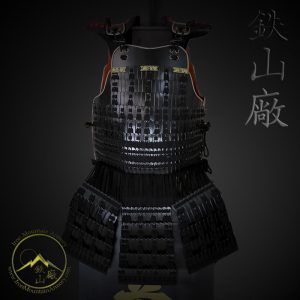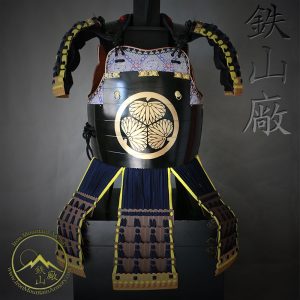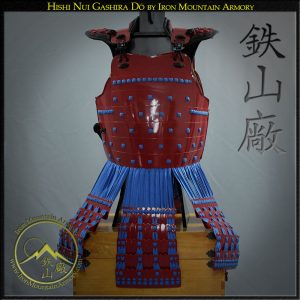- Traditionally Handcrafted
- Customizable
- Shipped Direct From The Armory
- Best Price Guarantee
- World wide delivery
Kiritsuke-Iyozane Hara-ate Do is a tosei (modern post 1550) cuirass made from lamellae style plating, which covers the front and side of the torso. Kiritsuke-Iyozane Hara-ate yoroi was commonly used by high ranking samurai and Daimyo during the late Sengoku era (waring state). The Taisho class design are fully handcrafted and detailed with the finest of materials. It features kiritsuke iyozane, which simulated wide scale plates along a “sane-ita”, or “ita-zane” plate design. Sugake Odoshi style lacing, referred to as “‘simple hang,”. This helped make this Tosei (modern) style of do to resemble the more traditional “hon iyo-zane”, which was crafted with individual wide scale plates laced together. This tosei design has the same look as the more traditional design but at half the cost, was more robust on the battlefield and easier to maintain.
Hara-ate Do (belly cover cuirass) dates back to the early 13th century and is a hybrid of the original hara-maki Do (belly wrap cuirass). The tosei hara-ate do was very likely a standard ni-mai do (2 section cuirass) with the backside removed and 2 adjustable straps added, to be worn while traveling or parading through safer areas. It was used by the samurai retainers of Daimyo and other high-ranking samurai as an economical, lightweight yoroi (armor). Into the peaceful Edo Era this style of yoroi would have likely been used during the marches to and from the capital. When worn with a jinbaori (vest) the back is covered and appears as a normal full ni-mai do (2 section cuirass) is being worn.
Select from the many custom options to design your own Kiritsuke-Kozane Hara-ate Do and the armorers at Iron Mountain Armory will be very happy to handcraft your custom yoroi for you. The hara-ate do is perfect for martial artists wanting to add a yoroi to their training, as well as historical re-enactors, cosplay and samurai enthusiast. This style of yoroi can be worn by itself or you can add sangu (armor parts) to give it the more full armor set. We recommend adding an uba-obi and sarashi to your order with this item. Does not include box, stand or obi-belt.
Features:
[table id=235 /]
Ordering Tips: IF you are between height options, We recommend that you order one size larger AND one size shorter than the size required. The armor is close fitting. It can close into itself if too big, or be a little uncomfortable if fitted too tall. If you’re planning on wearing a yoroi hitatare or a kikko gane do under the armor, we suggest adding 4 cm to your chest size when ordering.
[table id=PF /]
References: “Samurai Armour: Volume I: The Japanese Cuirass” by Trevor Absolon / “Art of the Samurai: Japanese Arms and Armor, 1156-1868″ by Kazutoshi Harada, Metropolitan Museum of Art



